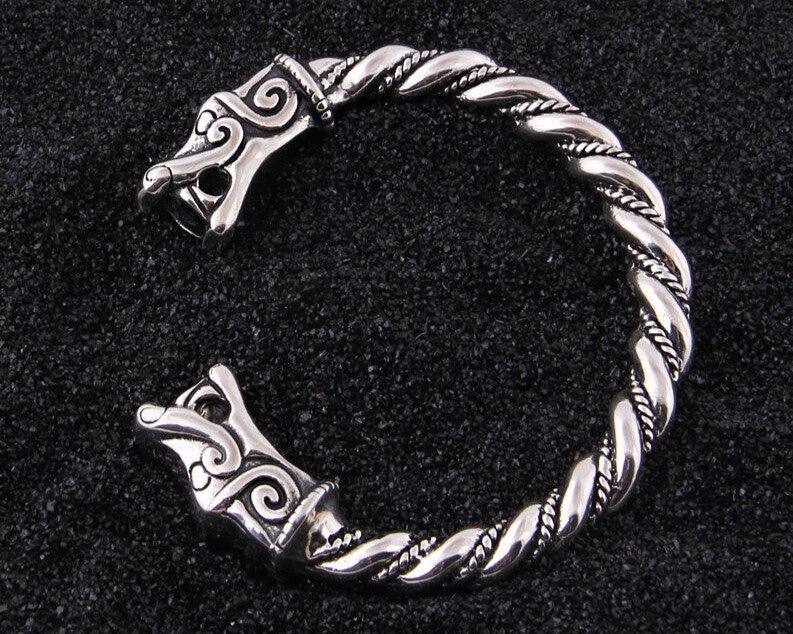Norse jewelry presented a diverse array of adornments for both men and women. These included neck rings, necklaces, bracelets, finger and toe rings, armrings, earrings, amulets and pendants, armbands, beads, and brooches to fasten their cloaks.
Reproduction of a bracelet found in the Spillings Hoard. This is the Spillings Hoard Viking Bracelet in 925 Sterling Silver, available here.
Men typically adorned neck rings, while women's necklaces were more intricate. Finger rings and armrings were distinguished mainly by size, and both armrings and armbands held ceremonial and social importance.
The Norse armring symbolized the transition from boyhood to manhood or a token of esteem from a superior to a subordinate. For instance, King Hrothgar in Beowulf embodied the "ring-giver" role – a generous lord rewarding those who pleased him. In emergencies, an armring could even be bent and a piece broken off to barter for goods or services.

Ingots and arm-ring fragments from the Furness Hoard. The two curved fragments (top left) fit together to form a complete ring.

Pieces of ‘hack-silver’. Used as bullion, these pieces are brooch fragments of mainly Irish type.
Another cherished jewelry piece was the pendant, encompassing diverse forms. Pendants commonly venerated deities and could manifest as a throne, a horse honoring Odin's steed Sleipnir, various weapons linked with Gods, and notably, Thor’s hammer Mjölnir. The Thor’s hammer pendant not only offered protection against threats but also bestowed personal strength, aiding one's journey through life.
Hammer of Thor Mjolnir Necklace in 925 Sterling Silver Skanen Replica available here.
A central part of the Norse religion is the concept of Wyrd, or fate. One’s path and even time of death is determined at birth, which emphasizes the way in which the individual acts towards fate, be it with courage and honor, or in a despicable way. The Völuspá from the Poetic Edda details the Norns, residing by Yggdrasil's roots at the Well of Urd, weaving destinies:
Three wise womenDwell there,
By the well
Under the tree.
One is called Urth,
Another Verthandi,
The third Skuld.
They shape destinies,
Craft life's laws,
And fix every human's
Lifespan and its end.
(Verse 20, Crawford, 6)
Facing an unknown fate, living each day fully was paramount. Personal grooming was vital, underscored by verses in Norse poetry like Hávamál and Reginsmál. Both texts specifically counselled attention to appearance before stepping out:
Always appearWith combed hair
And a meal inside,
Even if finer attire eludes you.
Neither your shoes nor pants
Should cause shame,
Nor your horse's quality,
Even if modest.
(Hávamál, 61; Crawford 28)
Personal and collective fates were sealed by the Norns. Hence, embracing life's pleasures, including dressing well and using jewelry was paramount.
The Norse peoples held a cultured aspect overlooked in chronicles. Bathing and hygiene, undervalued by Christians, were central to Norse culture. Jewelry such as arm-rings were not simple status symbols. They were tokens of loyalty, of honor, generosity and even of oaths taken, often swore while invoking the God Ullr.
The Old Norse poem Atlakviða show us how the most solemn oaths are sworn on the Ring of Ullr. This was a common practice, archaeologically proved in the only shrine to Ullr ever unearthed, in the city of Lilla Ullevi, Sweden. Excavations on the site found 65 Oath Rings dedicated to Ullr. The rings were apparently used for swearing oaths and then buried at his shrine.
Some of the 65 amulet rings excavated at Lilla Ullevi
Tomb finds stressed weaponry, yet artifacts related to grooming, like tweezers, combs, toothpicks, and washing bowls, were also prevalent. The Norse peoples embodied "dress for success," contributing to their allure and perhaps a reason why this facet often goes unnoticed in modern depictions.
The picture on the cover of this blog post is of the Sköll and Hati Sons of Fenrir 925 Sterling Silver Bracelet, available here.
Bibliography
Crawford, J. The Poetic Edda. Hackett Publishing Company, Inc., 2015.
Ellis Davidson, H. R. Myths and Symbols in Pagan Europe. Syracuse University Press, 1988.
Lindow, J. Norse Mythology: A Guide to the Gods, Heroes, Rituals, and Beliefs. Oxford University Press, 2002.
Magnusson, M. Vikings!. E.P. Dutton, NY, 2000.
Sawyer, P. The Oxford Illustrated History of the Vikings. Oxford University Press, 2001.
Simek, R. A Dictionary of Northern Mythology. BOYE6, 2008.
Somerville, A. A. & McDonald, R. A. The Viking Age: A Reader. University of Toronto Press, Higher Education Division, 2015.
Wolf, K. Viking Age: Everyday Life During the Extraordinary Era of the Norsemen. Sterling, 2013.















